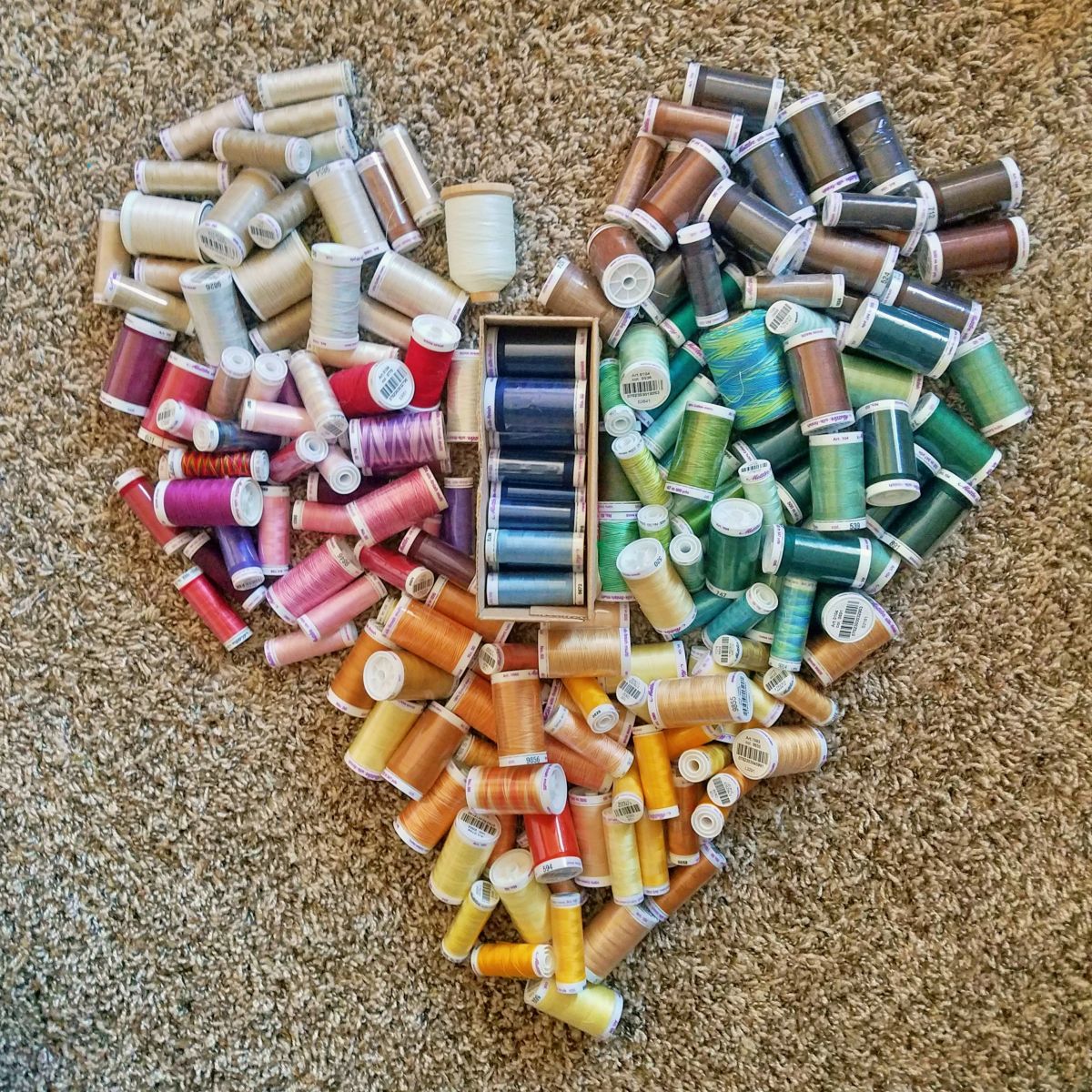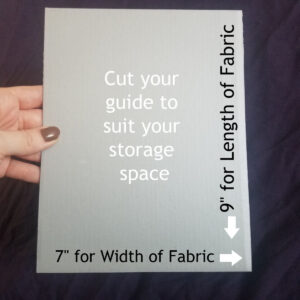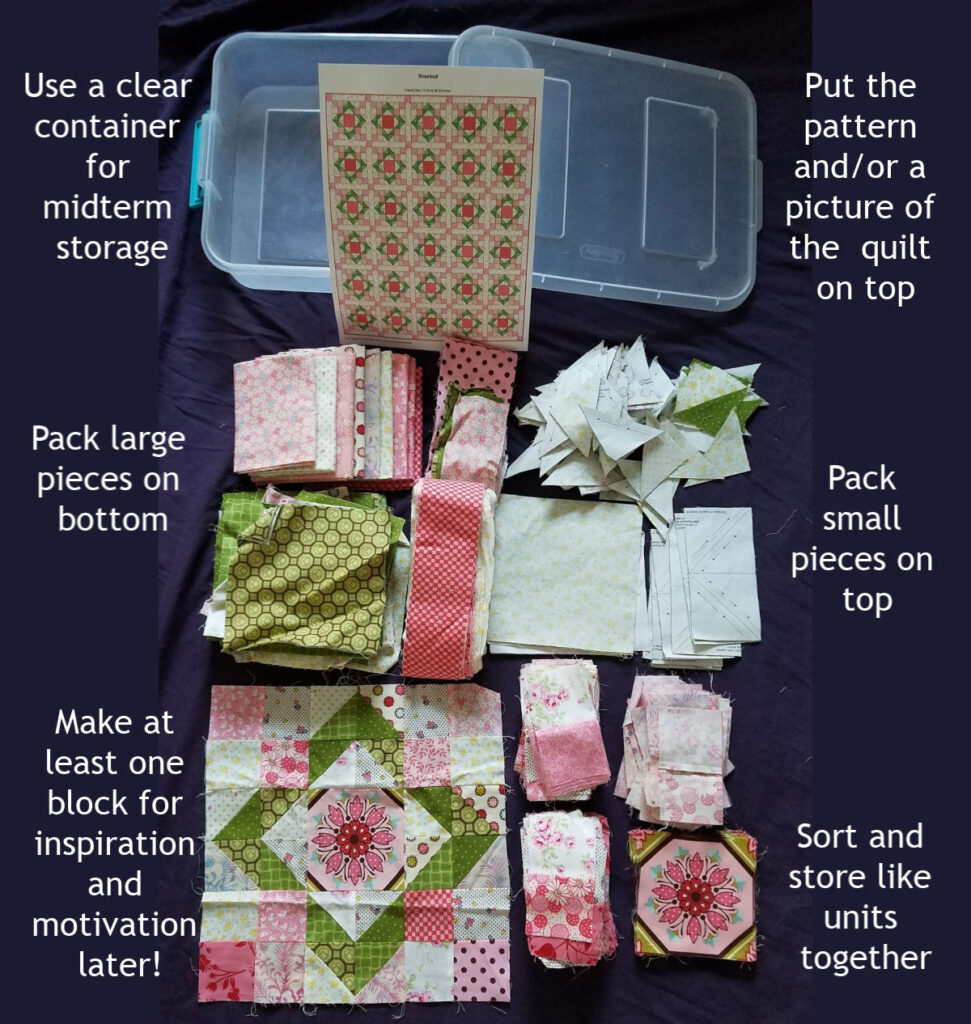
Everyone would love to have the perfect studio, well organized, stocked with every fabric we’ll ever need, and overflowing with creative vibes. We surveyed quilters to learn what atmosphere inspires creativity in you. The answers were as amazing and diverse. To kick things off, here is a word cloud of the responses…

The popularity of the words displayed are shown in size.
Question 1:
Besides your sewing machine, what stations or areas do you use for piecing?
#1 – Nine out of ten quilters use a Cutting Area
#2 – Eight out of ten quilters use a Ironing Area
#3 – Five out of ten quilters use a Design Area
#4 – Two out of ten quilters use a Quick Pressing Area
#5 – Two out of ten quilters use a Staging Area for Units & Blocks
Setting up these top five areas in close proximity to the sewing area helps streamline the piecing process.
Question 2:
What lighting solutions do you use to keep your work space well lit?
#1 – The most popular light sources are ceiling lights. Several wrote in that they use special bulbs in their fixtures to improve the quality of light.
#2 – Half the quilters responding reported using portable lights.
#3 – Just over 40% of quilters responding said they also benefit from floor lamps.
Of course it’s no surprise that the most popular write in answer was sunlight. If only the sun would shine bright every time we quilted.
Question 3:
How do you store your stash? Here are the favorites…
#1 – Shelves
#2 – Clear Boxes
#3 – Plastic Tubs
#4 – Drawers
#5 – Baskets
Question 4:
How large is your quilt library?
#1 – 25-50 books and patterns
#2 – 200+ books and patterns
#3 – 75-100 books and patterns
In the spirit of filling our studios with creative vibes, let’s take a look at some simple ways to create calm in the studio.
Sort drawers to see everything

Drawer storage space offers so much storage in a small space, but without some dividers, it can end up looking like the junk drawer. Create themes for a drawer so everything in a drawer makes sense together to you. For example, there is a “Sharp Things” drawer in my studio which has every cutting tool with an exposed blade (like rotary cutters and scissors) and a single awl, because where else would I put an awl? It makes sense to me, and that’s what matters in organizing our creative spaces.
Use smaller containers and dividers that can be seen through from above to further sort the contents of a drawer. Pictured above is a drawer with small containers holding Wonder Clips, sewing machine needles, miscellaneous machine parts, and hand needles. Above that are boxes of pins, a tin of hand quilting supplies ready to go, and another tin of sewing machine needles. In the center pencil organizer is sewing machine tools, and in the other is marking tools, a seam ripper and Tiger Balm to go with the hand quilting tin. Everything in this drawer is visible upon opening the drawer, making it easy to grab exactly what is needed.
Fold fabric with a guide for uniformity

It’s tempting to store fabric yardage however the person cutting it off the bolt decided to fold it, but this usually leads to some really different sized stacks of fabric. Create uniformity by making a folding guide.
To do this, grab some cardboard, a pencil, a ruler, and a cutting tool other than your fabric scissors. First, decide how you want to fold the width of the fabric, from folded edge to selvage. Most fabric is 21″ from fold to selvage, which can be divided equally into thirds. If you want to fold the width of fabric into fourths, cut the folding guide 5 1/4″ wide. Then decide how long you want the fabric to be when folded. If it suits your space, 9″ is nice because it’s a quarter yard, so most yardage cuts are easily divided by 9. Cut the length of the cardboard fabric guide to the size you prefer.

To fold, place the guide at the folded edge in the center of the yardage and fold the length of fabric in towards the guide. Do this until the fabric can wrap over the guide. Remove the guide and place it on top of the fabric. Holding the fabric and the guide together, fold the fabric towards the other end twice and slide the guide out from between the fold.
Pack UFOs for the future

When you pack up a UFO, you’re making a creative care package for your future self. Follow these tips for packing up UFOs, and your future self will thank you!
- Use a clear, breathable storage container, unless you know you won’t be returning to the project for a long time, in which case, try an acid-free box.
- Place larger pieces like borders and extra fabric in the bottom of the storage container.
- Sort and store all like units together.
- Pack smaller pieces towards the top of the storage container.
- Make at least one block for inspiration and motivation, pack it near the top so it’s one of the first things your future self pulls out.
- Place the pattern and/or a picture of the quilt on the very top so it’s the visible and easily identifiable through the clear lid.
What ways do you inspire creativity in your studio? Share your ideas in the comments below!